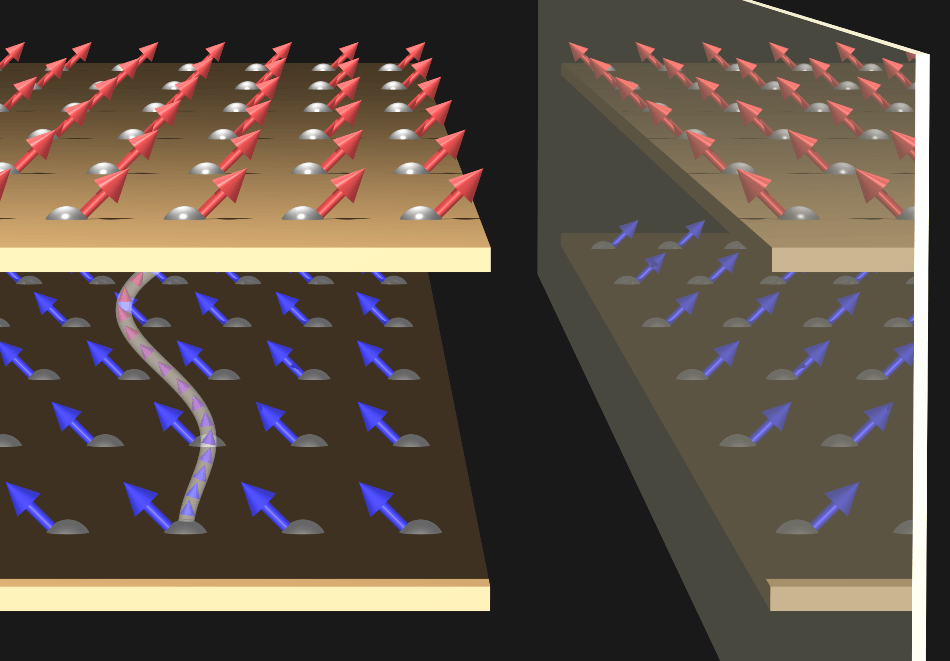Jun 14 2019
A global collaboration between scientists from the Netherlands, Germany, and South Korea has revealed a new kind of interaction of the electron spins in layered materials.
 The spins (red and blue arrows) in distant magnetic layers can couple due to the discovered long-range interaction, which is illustrated as a white string connecting two spins. This coupling leads to a clockwise canting between the spins in the two layers. Its depicted mirror image with the opposite sense of canting is not found in the considered systems. (Image credit: Forschungszentrum Jülich/Jan-Philipp Hanke)
The spins (red and blue arrows) in distant magnetic layers can couple due to the discovered long-range interaction, which is illustrated as a white string connecting two spins. This coupling leads to a clockwise canting between the spins in the two layers. Its depicted mirror image with the opposite sense of canting is not found in the considered systems. (Image credit: Forschungszentrum Jülich/Jan-Philipp Hanke)
Researchers reported in their study, published in the Nature Materials, a yet to be determined chiral coupling that is active over comparatively long distances. Consequently, spins in two different magnetic layers isolated by nonmagnetic materials can have an impact on each other even if they are far away.
Magnetic solids provide the basis for modern information technology. For instance, these materials are universally available in memories like hard disk drives. Efficiency and functionality of these devices are governed by the physical properties of the magnetic solids.
Their efficiency is due to the “concert of spins”—the interactions that occur among microscopically small magnetic moments inside the material. Understanding and focusing on this concert is a basic question for analysis and applications.
Despite being located far apart, the two magnetic materials can influence each other over long distances. Previously, such a long-range interaction has been found, for instance, in heterostructures of magnetic iron layers that are disconnected by a thin chromium spacer. A unique feature of what is called the interlayer coupling is the parallel or antiparallel order of the magnetic moments in the iron layers.
This aspect is technologically significant as the electrical resistance of the two probable configurations is markedly different—which is called giant magnetoresistance effect. It is used in working magnetic sensors and memories. In 2007, Peter Grünberg and Albert Fert jointly received the Nobel Prize in Physics for their discovery.
A research team has currently widened this “concert of spins” through a new kind of long-range interlayer coupling. The researchers reported in Nature Materials that the identified interaction led to a special configuration of the magnetic moments, which is not parallel or antiparallel but has a particular chirality. This shows that the resulting alignment of spins is different from its mirror image—quite similar to how a left hand is the mirror image of the right hand.
Such chiral interactions in crystals are very uncommon in nature. The scientists used theoretical simulations on the supercomputer JURECA in Jülich and found the interaction between the crystal structure and relativistic effects as the base for the observed chiral interlayer coupling. This aspect of the “concert of spins” provides new possibilities for producing complicated magnetic configurations that are possibly useful in storing and processing data more efficiently in the future.